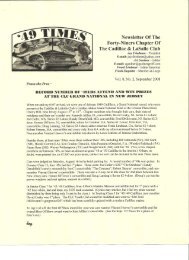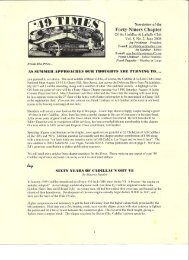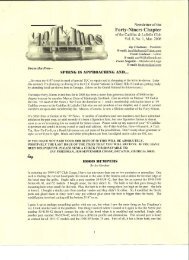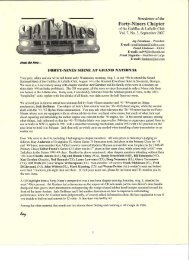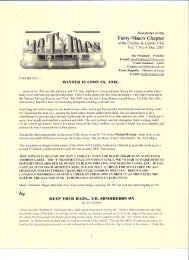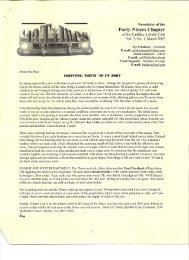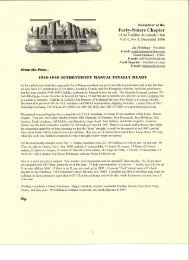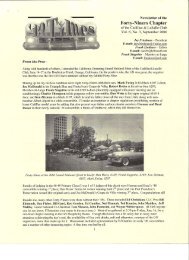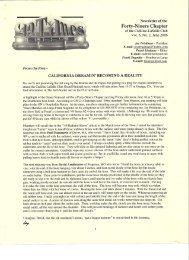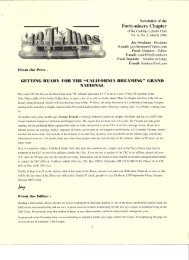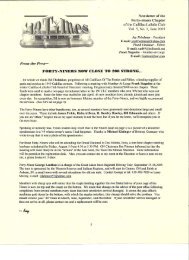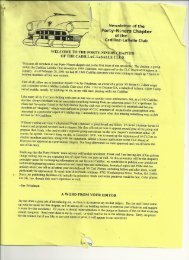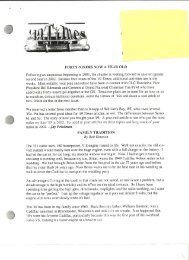Create successful ePaper yourself
Turn your PDF publications into a flip-book with our unique Google optimized e-Paper software.
only special tool needed is a torque wrench. On the other hand, there are lots of parts to remove (and later re-install) and the<br />
heads are heavy, weighing more than 50 pounds each, so it can be a 2-person job.<br />
The first task is to completely drain the coolant from the radiator and engine block. To do this, first raise the front of<br />
the car on jack stands. The motor has 2 small drain outlets on either side of the middle of the block, just above the oil pan.<br />
The Cadillac factory closed these off with small pipe plugs, which when removed usually results in the coolant flowing out in<br />
the wrong direction and making a mess. I replaced mine with drain cocks identical with the radiator drain cock, so I can put a<br />
rubber hose on each to direct the flow into buckets. While you are under the car, remove the oil dipstick tube and dipstick.<br />
Back on top, after lowering the car, unfasten one of the battery cables and remove the windshield washer bottle and bracket.<br />
Next, remove the rubber fuel line. Then, drain the oil filter if you have one. Now, disconnect the upper and lower oil<br />
filter tubes at the oil filter end, leaving the tubes attached to the motor, and remove the oil filter. Unfasten the 4 bolts holding<br />
the thermostat housing to the water pump. Loosen the upper radiator hose clamp, turn the upper hose on the radiator outlet one<br />
quarter to one half turn to free the thermostat housing and remove the hose and the thermostat housing as a unit. Remove the<br />
fan belt, the fan and the generator along with its adjusting strap. Remove the lower radiator hose. Now the radiator and water<br />
pump can be unbolted and removed. I find it‘s easier for 2 people to lift the radiator.<br />
The next task is to remove the intake manifold. First, remove the air cleaner. Next, remove the accelerator linkage<br />
spring and unhook the accelerator linkage from the carburetor. Fold the accelerator linkage back against the firewall and hook<br />
it under one of the hoses or wires on the firewall. Disconnect the Hydramatic ―kickdown‖ rod at the carburetor and<br />
transmission ends and remove it from the car. Disconnect the vacuum advance tube at both ends and remove it. Disconnect<br />
the manifold vacuum tube at the fuel pump end. Disconnect the automatic choke tube at both ends and remove it from the car.<br />
Disconnect all wires from the coil (back-up light wire, coil power wire, coil to distributor primary and secondary<br />
wires) and tie them back to a hose or wire at the firewall. Disconnect the fuel pump to carburetor tube at the carburetor end.<br />
Tilt it up to a sufficient angle on the fuel pump that fuel doesn‘t flow out but leave it in place. Loosen and remove the four<br />
bolts and four nuts with their washers that hold the intake manifold to the cylinder heads. Now the manifold can be removed<br />
with the manifold-to-fuel pump vacuum tube, carburetor and coil still attached. One person can lift it, it may be easier if you<br />
are two people.<br />
Now the heads are almost ready to remove. Starting with the driver‘s side head, unthread the spark plug cables from<br />
the loops on the valve cover on a late motor, or unfasten the spark plug wire conduits on an early motor, and tie them up to a<br />
hose or wire on the firewall. Remove the valve cover and set it aside. Remove the water hose that runs between the head and<br />
the defroster assembly. (I find it easiest to cut this hose, as it is hard to get a good grip to pull it off.) Unscrew the cylinder<br />
head ground strap at the firewall end. Now, unscrew the cylinder head bolts. Since the rocker arm assembly is full of oil,<br />
before removing it get a pan or other receptacle longer than the rocker arm assembly. With the pan ready to catch any oil, lift<br />
off the rocker arm assembly with its four bolts and set aside on the pan.<br />
Remove the push rods. You must re-install the push rods with the same end toward the rocker arms and, preferably,<br />
in the same valve lifter. Note the shape of the push rod at each end. Punch holes in a piece of card board, number the holes<br />
with a pen or pencil and, to keep them organized, insert the push rods into the holes in numerical order with their top ends up.<br />
Remove the 6 exhaust manifold bolts. Leave the exhaust manifold in place, since the crossover pipe is very rigid and will<br />
easily support the exhaust manifold after the head is removed.<br />
Getting the passenger‘s side head ready is similar. Unscrew the nut holding the wire to the water temperature sending<br />
unit. The voltage regulator can be left in place, but you risk banging the head into it. I usually unscrew the voltage regulator<br />
mounting screws and lay the regulator with its wires still attached on the nearby shock absorber with a rag underneath it. Deal<br />
with everything else in the same manner as the driver‘s side head. The crossover pipe and exhaust pipe are very rigid and will<br />
support the exhaust manifold easily after the head is removed.<br />
Before lifting off the heads, it‘s a good idea to put some towels or other protection on the fenders and on the baffle in<br />
front of the radiator. If a head is stuck, tap it with a hard rubber hammer to dislodge it. You can grab the head by the water<br />
pump hole at one end and either the heater pipe, temp gauge sending unit or the ground strap at the other end. An assistant‘s<br />
help can be useful at this point. Alternatively, you could use a ―cylinder head lifting tool‖, which are T-shaped tools that screw<br />
into the spark plug holes. You then pick up the head by the ―T‖ crossbar. I have two I‘ll lend to anyone who needs them. On<br />
the bench, remove the driver‘s side head heater hose pipe, the passenger‘s side head temperature gauge sending unit, both<br />
ground straps and the small pipe plugs at the rear of the passenger‘s head and the front of the driver‘s head.<br />
Have your heads rebuilt in a reputable shop. It‘s a good idea to have the re-builder install hardened steel exhaust<br />
valve seats so the engine can better cope with unleaded fuel.<br />
Re-install everything in reverse order. Head gaskets will say ―TOP‖ on one side, so lay new ones thusly on the block<br />
with the guide studs engaged. Carefully lay the heads on the block, engaging the guide studs underneath it and ensuring that<br />
the gasket is not folded back or kinked. Torque the head bolts to 65-70 foot pounds in the order shown on the next page:



